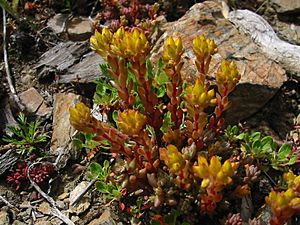Spearleaf stonecrop facts for kids
Quick facts for kids Spearleaf stonecrop |
|
|---|---|
 |
|
| Scientific classification | |
| Genus: |
Sedum
|
| Species: |
lanceolatum
|
Sedum lanceolatum, also known as spearleaf stonecrop or lanceleaf stonecrop, is a fascinating flowering plant. It belongs to the Crassulaceae family, which is often called the stonecrop family. This plant is a type of succulent plant, meaning it has thick, fleshy parts that store water.
You can find Sedum lanceolatum growing naturally across western North America. Its range stretches from Alaska in the north, all the way down to Arizona and New Mexico. It also grows east into states like South Dakota and Nebraska. This hardy plant loves rocky mountain areas, often found high up in places like the Rocky Mountains. It can grow at elevations up to 4,048 meters (about 13,280 feet)! During past ice ages, this plant survived and adapted in special isolated areas.
This plant forms a cluster of leaves at its base, shaped like rosettes. These leaves can be knobby or pointed and grow up to 3 centimeters long. Smaller leaves appear higher on the stem. When the plant blooms, these smaller leaves often fall off.
Contents
What Sedum lanceolatum Looks Like
The plant produces one or more tall stems that hold its flowers. These flowers have yellow petals, which sometimes have a touch of red. Each petal is shaped like a lance and is just under a centimeter long. The stamens, which are the parts that produce pollen, have yellow tips.
How Sedum lanceolatum Reproduces
This plant can make new plants in two ways:
- By seeds: It produces tiny, very light seeds that can be carried by wind or water to new places. This is called sexual reproduction.
- By pieces of itself: If a part of its stem breaks off, it can often grow roots and become a new plant. This is known as vegetative reproduction.
Ecology and Interactions with Animals
Sedum lanceolatum plays an important role in its ecosystem, especially for a certain butterfly.
A Home for Butterflies
This plant is a special food source for the caterpillars of the Parnassius smintheus butterfly. These caterpillars eat the leaves of Sedum lanceolatum.
Plant Defenses and Caterpillar Strategies
Sedum lanceolatum makes a special chemical called sarmentosin. This chemical helps protect the plant from animals that might want to eat it. It's like a natural bug repellent!
Interestingly, the Parnassius smintheus caterpillars are not harmed by this chemical. Instead, they store the sarmentosin from the plant inside their own bodies. This makes the caterpillars taste bad to predators, protecting them!
However, if the Sedum lanceolatum plant gets damaged, for example, by a machine, it can make it harder for the caterpillars to grow. This might be because the plant creates even more defenses when it's hurt.
Caterpillars feeding on the plant also cause it to produce defenses. Because of this, the caterpillars often eat quickly and then move to another plant. They usually feed and leave a plant in less than 30 minutes!
Seasonal Challenges for Caterpillars
From November to February, the leaves of Sedum lanceolatum become very harmful to the caterpillars. If the butterfly eggs hatch too early, before March, and there is still snow, the caterpillars will try to eat the toxic leaves and won't survive. But for the rest of the year, the caterpillars can eat the leaves and grow normally.

